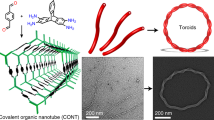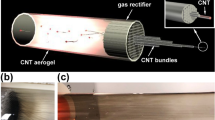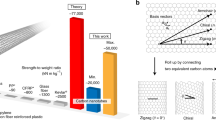Abstract
Since their discovery, the possibility of connecting carbon nanotubes together like water pipes has been an intriguing prospect for these hollow nanostructures. The serial joining of carbon nanotubes in a controlled manner offers a promising approach for the bottom-up engineering of nanotube structures—from simply increasing their aspect ratio to making integrated carbon nanotube devices. To date, however, there have been few reports of the joining of two different carbon nanotubes1,2,3. Here we demonstrate that a Joule heating process, and associated electro-migration effects, can be used to connect two carbon nanotubes that have the same (or similar) diameters. More generally, with the assistance of a tungsten metal particle, this technique can be used to seamlessly join any two carbon nanotubes—regardless of their diameters—to form new nanotube structures.
This is a preview of subscription content, access via your institution
Access options
Subscribe to this journal
Receive 12 print issues and online access
$259.00 per year
only $21.58 per issue
Buy this article
- Purchase on Springer Link
- Instant access to full article PDF
Prices may be subject to local taxes which are calculated during checkout



Similar content being viewed by others
References
Terrones, M., Terrones, H., Banhart, F., Charlier, J.-C. & Ajayan, P. M. Coalescence of single-walled carbon nanotubes. Science 288, 1226–1229 (2000).
Terrones, M. et al. Molecular junctions by joining single-walled carbon nanotubes. Phys. Rev. Lett. 89, 075505 (2002).
Wang, M. S., Wang, J. Y., Chen, Q. & Peng, L. M. Fabrication and electrical and mechanical properties of carbon nanotube interconnections. Adv. Funct. Mater. 15, 1825–1831 (2005).
Huang, J. Y. et al. Superplastic carbon nanotubes. Nature 439, 281 (2006).
Ding, F., Jiao, K., Lin, Y. & Yakobson, B. I. How evaporating carbon nanotubes retain their perfection? Nano Lett. 7, 681–684 (2007).
Yoo, M. et al. Zipper mechanism of nanotube fusion: theory and experiment. Phys. Rev. Lett. 92, 075504 (2004).
Dunlap, B. I. Relating carbon tubules. Phys. Rev. B 49, 5643–5650 (1994).
Hashimoto, A., Suenaga, K., Golter, A., Urita, K. & Iijima, S. Direct evidence for atomic defects in graphene layers. Nature 430, 870–873 (2004).
Zhao, Y. F., Yakobson, B. I. & Smalley, R. E. Dynamic topology of fullerene coalescence. Phys. Rev. Lett. 88, 185501 (2002).
Zhao, Y. F., Smalley, R. E. & Yakobson, B. I. Coalescence of fullerene cages: topology, energetics, and molecular dynamics simulation. Phys. Rev. B 66, 195409 (2002).
Han, S. et al. Microscopic mechanism of fullerene fusion. Phys. Rev. B 70, 113402 (2004).
Stone, A. J. & Wales, D. J. Theoretical studies of icosahedral C60 and some related species. Chem. Phys. Lett. 128, 501–503 (1986).
Bandow, S., Takizawa, M., Hirahara, K., Yudasaka, M. & Iijima, S. Raman scattering study of double-wall carbon nanotubes derived from the chains of fullerenes in single-wall carbon nanotubes. Chem. Phys. Lett. 337, 48–54 (2001).
Pop, E., Mann, D., Wang, Q., Goodson, K. & Dai, H. Thermal conductance of an individual single-wall carbon nanotube above room temperature. Nano Lett. 6, 96–100 (2006).
Sorbello, R. S. Theory of electromigration. Solid State Phys. 51, 159–231, (1998).
Suenaga, K. et al. Imaging active topological defects in carbon nanotubes. Nature Nanotech. 2, 358–360 (2007).
Regan, B. C., Aloni, S., Ritchie, R. O., Dahmen, U. & Zettl, A. Carbon nanotubes as nanoscale mass conveyors. Nature 428, 924–927 (2004).
Svensson, K., Olin, H. & Olsson, E. Nanopipettes for metal transport. Phys. Rev. Lett. 93, 145901 (2004 ).
Iijima, S. & Ichihashi, T. Structural instability of ultrafine particles of metals. Phys. Rev. Lett. 56, 616–619 (1986).
Kiang, C. H., Goddard III, W. A., Beyers, R., Salem, J. R. & Bethune, D. S. Catalytic effects of heavy metals on the growth of carbon nanotubes and nanoparticles. J. Phys. Chem. Solids 57, 35–39 (1996).
Raty, J.-Y., Gygi, F. & Galli, G. Growth of carbon nanotubes on metal nanoparticles: a microscopic mechanism from ab initio molecular dynamics simulations. Phys. Rev. Lett. 95, 096103 (2005).
Rodriguez-Manzo, J. A. et al. In situ nucleation of carbon nanotubes by the injection of carbon atoms into metal particles. Nature Nanotech. 2, 307–311 (2007).
Endo, M. et al. Atomic nanotube welders: boron interstitials triggering connections in double-walled carbon nanotubes. Nano Lett. 5, 1099–1105 (2005).
Dyke, W. P. & Trolan, J. K. Field emission: large current densities, space charge, and the vacuum arc. Phys. Rev. 89, 799–808 (1953).
Ajayan, P. M. et al. Growth of manganese filled carbon nanofibers in the vapor phase. Phys. Rev. Lett. 72, 1722–1725 (1994).
Acknowledgements
C.J. thanks the Japan Society for Promotion of Science for a postdoctoral fellowship. The work on microscopy is partly supported by CREST.
Author information
Authors and Affiliations
Contributions
C. J., K.S. and S.I. conceived and designed the experiments. C.J. performed the experiments and analysed the data. C.J. and K.S. co-wrote the paper. All authors discussed the results and commented on the manuscript.
Corresponding authors
Supplementary information
Supplementary Information
Supplementary figures S1–S3, supplementary tables S1 and S2, and supplementary movie captions (PDF 783 kb)
Supplementary Information
Supplementary Movie 1 (MOV 2858 kb)
Supplementary Information
Supplementary Movie 2 (MOV 1996 kb)
Supplementary Information
Supplementary Movie 3 (MOV 789 kb)
Supplementary Information
Supplementary Movie 4 (MOV 1075 kb)
Supplementary Information
Supplementary Movie 5 (MOV 4861 kb)
Supplementary Information
Supplementary Movie 6 (MOV 749 kb)
Supplementary Information
Supplementary Movie 7 (MOV 6126 kb)
Rights and permissions
About this article
Cite this article
Jin, C., Suenaga, K. & Iijima, S. Plumbing carbon nanotubes. Nature Nanotech 3, 17–21 (2008). https://doi.org/10.1038/nnano.2007.406
Received:
Accepted:
Published:
Issue Date:
DOI: https://doi.org/10.1038/nnano.2007.406
This article is cited by
-
Tensile Strength of Thin Pt Wires Welded by Joule Heat
Journal of Materials Engineering and Performance (2023)
-
The use of potential drop measurements to predict the temperature distribution in a thin wire with current flowing through it
Microsystem Technologies (2021)
-
Cantilever self-excited with a higher mode by a piezoelectric actuator
Nonlinear Dynamics (2021)
-
Water distillation modeling by disjoint CNT-based channels under the influence of external electric fields
Journal of Molecular Modeling (2020)
-
Nanojunction Effects on Water Flow in Carbon Nanotubes
Scientific Reports (2018)



